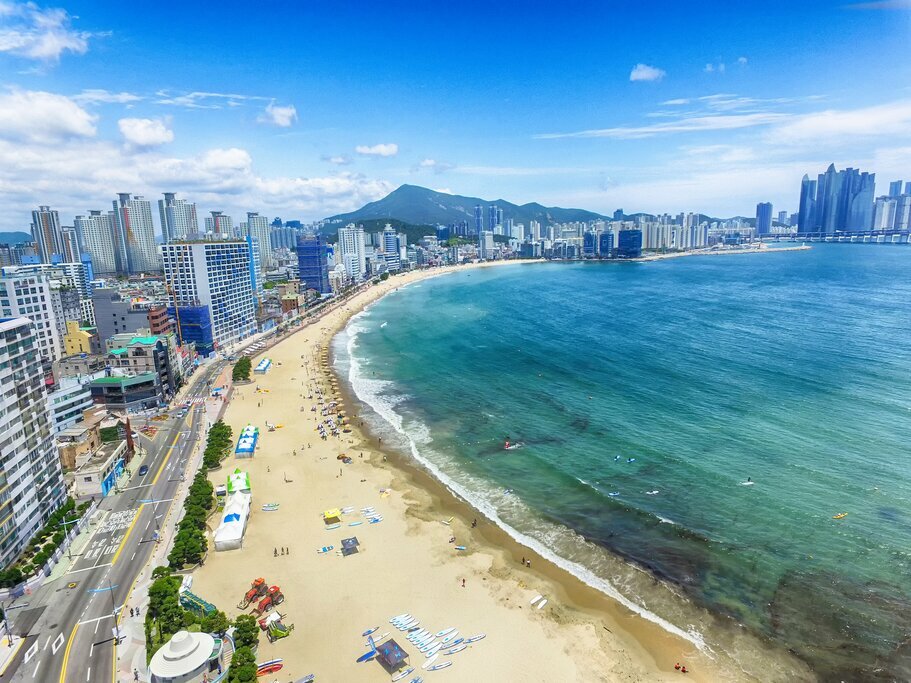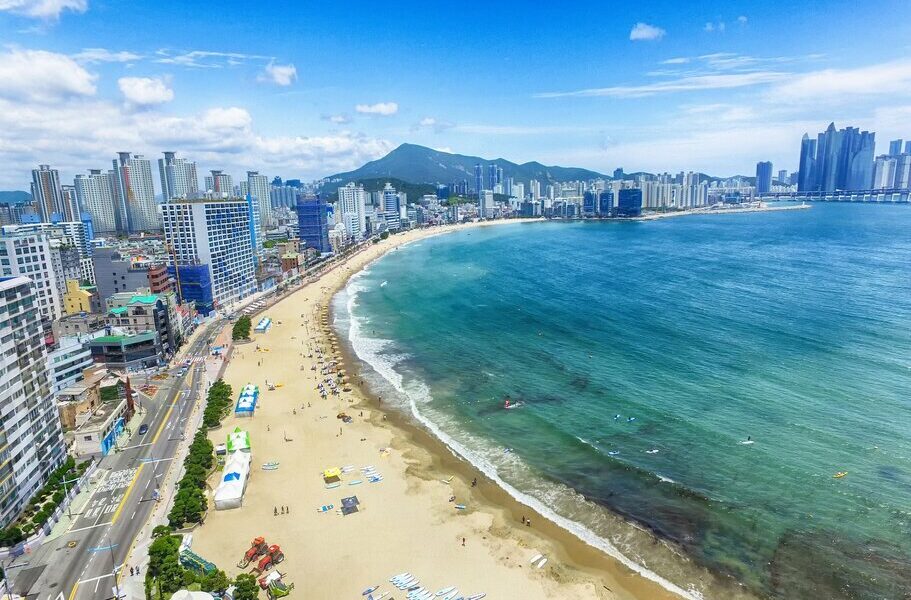
Temperatures and humidity levels reach an annual high in July, leading tourists to flock to South Korea’s coastal cities, where the east coast offers world-class beaches and summer festivals. Soak up the sun on one of Busan’s seven public beaches, or travel to Gangneung in the northeast to take in a legendary sunrise over the water. With children out of school, July can see significant crowds at beaches and tourist attractions, so be sure to arrive early to popular destinations.
The following offers a revised version of the provided content, significantly expanding upon the original while retaining all place names.
Weather in South Korea During July
July in South Korea is characterized by intense heat, with average temperatures often reaching a high of 81°F (27°C). This makes it one of the warmest months of the year, rivaled only by August. The warmth persists well into the evening hours, with temperatures rarely falling below a balmy 70°F (21°C), even after sunset. For travelers planning a visit during this time, it is essential to be prepared for consistently high temperatures that can lead to discomfort if precautions are not taken. Staying hydrated is crucial, so carrying a water bottle and refilling it frequently throughout the day is highly recommended.
The rising temperatures throughout July mean visitors should pack lightweight, breathable clothing to stay as comfortable as possible. Opt for loose-fitting garments made from natural fibers like cotton or linen, which will help the body stay cool. Sunscreen is also a necessity, as the sun’s rays can be quite strong, even on days when the sky is overcast. Sunglasses and a wide-brimmed hat can provide additional protection from the sun’s glare and heat.
However, the heat is not the only weather factor to consider during a July visit to South Korea. This month also marks the peak of the annual monsoon season, known locally as *jangma*. As such, July is typically the rainiest month of the year, with Seoul experiencing an average rainfall of 15.5 inches (395 mm). The monsoon season generally begins in late June and extends throughout July, bringing with it periods of heavy rain and, in some cases, the possibility of flooding and typhoons. Travelers should monitor weather forecasts closely and be prepared for sudden changes in conditions.
The combination of heat and heavy rainfall can create a very humid environment. Average sunshine hours are typically limited to around four hours per day, meaning that many days are overcast and cloudy. An umbrella and rain boots are essential items to pack for a July trip. Even on days when the sun does peek through the clouds, visitors should be aware of the high humidity levels, which can reach up to 90%. This level of humidity can make even moderate temperatures feel much hotter and more uncomfortable.
Given the heat and rain, many travelers find that indoor activities are particularly appealing during July. Museums, art galleries, shopping malls, and cultural centers provide respite from the weather. However, when the sun does shine, the beaches become popular destinations, offering a chance to cool off in the ocean. Careful planning and awareness of the weather conditions are key to ensuring a pleasant and enjoyable trip to South Korea in July.
Crowds and Costs During Peak Season
With South Korean schools on their summer break, July sees a noticeable increase in family travel within the country. This surge in domestic tourism leads to higher crowd levels at popular tourist attractions across South Korea. Destinations specifically geared towards children, such as the country’s famous amusement parks like Lotte World and Everland, are particularly likely to be crowded. It is not uncommon to experience long lines for rides, shows, and food vendors. Planning ahead and arriving early can help mitigate some of the congestion.
The beautiful beaches of South Korea also experience an influx of visitors during July, especially on sunny days. The top beach destinations, including Busan, Gangneung, and Jeju Island, often see large crowds of sunbathers, swimmers, and water sports enthusiasts. Finding a prime spot on the sand can be challenging, especially during peak hours. The best strategy to avoid the biggest crowds is to arrive early in the morning. This allows you to secure a good location and enjoy the beaches before they become too packed.
Beyond the crowds, travelers should also be aware that the increased demand during peak season can drive up prices for flights and accommodations. Airfare to South Korea tends to be more expensive in July, and hotels, guesthouses, and other lodging options may charge higher rates. Booking flights and accommodations well in advance is highly recommended to secure the best possible prices and avoid last-minute disappointments.
However, there are ways to offset the increased costs associated with traveling to South Korea during the peak season. One strategy is to take advantage of the country’s numerous free and low-cost activities. South Korea boasts a wealth of parks, gardens, museums, and cultural heritage sites that offer enriching experiences without breaking the bank. Exploring these attractions can provide a more budget-friendly alternative to expensive theme parks or tours. Pack a picnic to enjoy in one of South Korea’s scenic parks, or take advantage of public transportation to explore different neighborhoods and cultural districts. With careful planning and a little creativity, you can enjoy a fantastic trip to South Korea in July without overspending.
Exploring South Korea: Where to Go in July
The vibrant city of Busan, situated on South Korea’s southeastern coast, consistently ranks as one of the country’s most sought-after summertime destinations. Known for its beautiful beaches and lively atmosphere, Busan offers something for everyone. With seven public beaches to choose from, visitors are spoiled for choice when it comes to sunbathing, swimming, and engaging in various water sports. Haeundae Beach is perhaps the most famous, but Gwangalli Beach, Dadaepo Beach, and Songjeong Beach are also worth exploring. Each beach offers a unique vibe and set of amenities, so take some time to discover your favorite.
Beyond its beaches, Busan boasts a rich cultural heritage and diverse attractions. A visit to the colorful hillside village of Gamecheon is a must. Known as the “Machu Picchu of Busan,” Gamecheon is a labyrinth of brightly painted houses, winding alleyways, and art installations. Another worthwhile excursion is to Beomeosa, a 1,300-year-old Buddhist temple nestled in the mountains just outside the city. Beomeosa offers a peaceful retreat from the bustling city and a chance to experience traditional Korean architecture and spirituality. Don’t forget to sample the local cuisine at one of Busan’s many street food markets, where you can find an array of delicious and affordable dishes.
For a change of pace, consider a day trip to nearby Geoje Island. Located just a short ferry ride from Busan, Geoje Island offers a slower pace of life and stunning natural beauty. The island is home to pristine beaches, lush forests, and picturesque fishing villages. Hiking and exploring the island’s coastline are popular activities. Geoje Island is a great choice for travelers who want to escape the crowds and immerse themselves in nature.
Gangneung, a charming coastal city located in the northeast of South Korea, provides an attractive alternative (or a valuable addition) for beach enthusiasts. Gangneung is known for its stunning sunrises, beautiful beaches, and rich history. Start your day by witnessing the breathtaking sunrise at the aptly named Jeongdonjin Sunrise Park, a spot that attracts visitors from all corners of the country eager to experience the magical morning views.
After the sunrise, head to Gyeongpo Beach, consistently ranked among the most popular beaches in South Korea. Gyeongpo Beach is famous for its soft, white sand and clear, blue waters. In addition to its beaches, Gangneung has a rich historical and cultural heritage. Tourists can visit well-preserved aristocratic residences that date back to the Joseon dynasty, offering a glimpse into Korea’s past. Gangneung offers a delightful blend of natural beauty and cultural attractions.
Activities and Experiences to Enjoy
The hot, sunny weather in July inevitably draws both locals and tourists to the beaches. Be prepared for crowds and try to arrive early to secure a prime spot on the sand. A well-stocked beach bag with sunscreen, towels, water, and snacks is essential for a comfortable day at the beach.
If you are lucky, your beach trip might coincide with one of South Korea’s exciting summer festivals. The Boryeong Mud Festival at Daecheon Beach is a unique and memorable experience. The festival celebrates the region’s mineral-rich mud with mud wrestling, mudslides, and other fun activities. The Busan Sea Festival is another highlight of the summer calendar. Spanning five beaches across the city of Busan, this festival offers vibrant nightlife, concerts, dance parties, and a lively atmosphere.
For families traveling with children during the summer vacation, there are plenty of kid-friendly activities to enjoy. In Seoul, Lotte World is a must-visit destination. Lotte World features an outdoor amusement park, as well as one of the world’s largest indoor theme parks, making it a perfect option for rainy days. Alternatively, consider a day trip to Everland, South Korea’s largest theme park. Located about three hours from Seoul, Everland attracts over five million visitors each year.
In addition to the theme parks, Seoul offers a variety of educational and engaging activities for children. The Seoul Children’s Museum provides interactive exhibits that encourage learning through play. The COEX Aquarium is another popular attraction, showcasing a diverse collection of marine life.
Even if you find yourself caught in the rain in a popular tourist destination like Busan or Jeju Island, there is no need to despair. Both cities offer a wide range of indoor activities to keep you entertained. In Busan, explore the fresh seafood shops of Jagalchi Market, where you can witness the bustling atmosphere and sample the freshest catches of the day. The Sea Life Busan Aquarium is another great option, offering a fascinating glimpse into the underwater world.
On Jeju Island, the Yeomiji Botanical Garden is a wonderful place to spend a rainy afternoon. The garden features more than 2,000 tropical and subtropical plants, providing a lush and vibrant escape from the weather.
July Events and Festivals
* **Boryeong Mud Festival, Daecheon Beach:** This unique festival in Boryeong celebrates the region’s mineral-rich mud, offering a range of activities like mud wrestling and giant mudslides. It usually takes place in July and August.
* **Busan Sea Festival, Busan:** This vibrant summer festival spans five beaches across Busan, offering a variety of events including concerts, dance parties, and nightlife activities at the end of July and beginning of August.
* **Buyeo Seodong Lotus Festival, Buyeo:** Taking place during the peak of the lotus season in July, this festival in Buyeo features stunning displays of lotus flowers, fireworks, a multimedia show, and canoeing through the lotus fields.
* **Pohang International Fireworks Festival, Pohang:** This spectacular event includes an international fireworks competition, along with a lively parade, DJ concerts, and other entertainment.
The word count of the re-written content is 1359 words.
B-2317

